#Cantaloupe Seedlings
Text
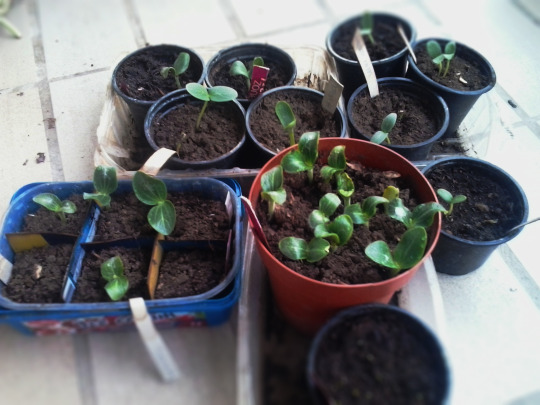

All of my belatedly planted squash and cantaloupes, they came out of the soil very quickly! Stuff you can see here are zuchinni, hokkaido squash, butternut squash, kabocha squash, pumpkin, cantaloupe and cucumber. Once they get one true leaf they can go outside, and I'm already planting them outside because they outgrow the little cups VERY quickly. I'm sharing them with other gardeners too because this is a lot!
Also, I ran out of soil while sowing this, so I put a few seeds in just decomposing leaves, to see if it would work. It worked. The far right container is just leaves. They're growing in there not minding it at all, and they'll get to real soil very soon.
#baby squash#baby cantaloupes#transplants#gardening#growing food#squash and cantaloupes#baby plants#tiny plants#seedlings
11 notes
·
View notes
Text
Gardening time!
This year I'm having to start mostly with seedlings because I've been busy working on my book (which is now out and published if anyone's interested!) and I finally get to do the things I want!
We're starting off small with an osteopernum! I'm planting the osteopernum in my pollinator area, where I think it's definitely going to stand out some!

(this is my osteopernum, ain't he just the sweetest)
Fun fact about osteoperum: osteopernum is a type of African daisy and it gets its name from its hard seeds! Osteo means bone, and sperma means seed! So it's literally bone seed! Pretty bad ass if you ask me. (Source)
Next is my cantaloupe! This was really an impulse buy, but I really wanted to try something new this year and this fits the bill!
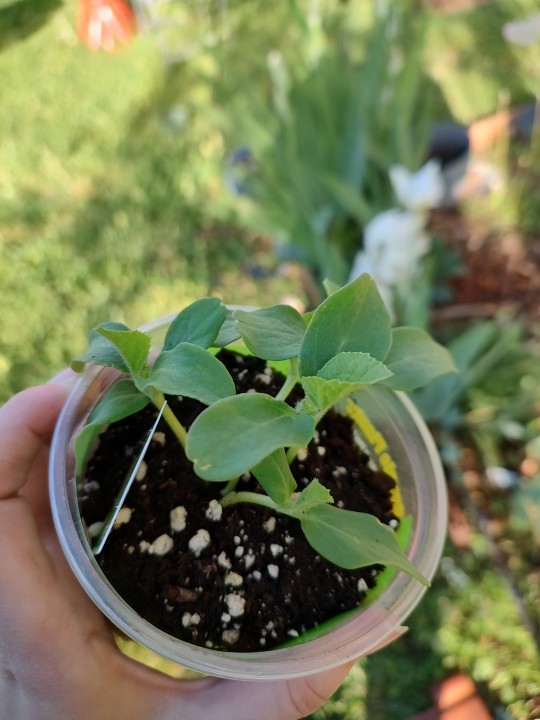
These guys seem to grow fast, as the day I got them, maybe 4 days ago, they didn't have any of their true leaves and were much smaller! Now though they're getting their first true leaves and are looking good (for now, I may accidentally kill them lol)
Fun fact about cantaloupe: cantaloupes take 80-90 days to mature and are typically ready to pick when the stem turns brown or yellow! (Source)
Whether or not these plants live or die, atleast I got outside and did something for once, my depressions been bad, but at least now I'm finally moving some!
3 notes
·
View notes
Text
There is something special about living in an agricultural-centered place. The passage of time is noted through plants and animals and the people whose lives revolve around them.
In January, the dairies plant the alfalfa. Wide open fields of little green seedlings.
February is the loveliest time of year: when the almonds blossom. The entire valley is covered in a blanket of blossoms of white touched with red. They cluster on every branch. Bee boxes are put out on every row.
The end of March is marked by the tiny green almond leaves replacing the blossoms, and every car stirs up a storm of white.
With spring, comes the baby animals. Calves, foals, lamb, piglets, kids. The fields are green and ducklings swim in the canals.
The alfalfa is harvested in May. God help you if you are allergic to hay. Combines stir up dust filled with bits of hay, every breeze is filled with it. Trucks carrying bales of alfalfa fill the roads, trailing bits of green and brown as they go.
Corn is planted in the empty alfalfa fields. The dairies begin to store the feed. Walnuts gain their leaves. The almonds begin to grow.
The first crop of summer: strawberries, followed closely by cherries. Peaches, nectarines, apricots, last is the watermelon, the cantaloupe. Fruit stands on every corner. The corn grows ever higher.
Fall is the time of harvest. It starts with the almonds. Tractors fill the streets, shakers, sweepers, harvesters, forcing cars to swerve around them. Dust clouds fill the air, the plumes can be seen for miles. As September creeps into October, open trucks filled with almonds are everywhere you look. Then tomatoes, covering the roads when spilled. Potatoes, squash, onions, sweet potatoes, pumpkins, apples, pears. Walnuts. Corn. Then the vineyards begin to harvest. It is the busiest time of year.
It is also time for calves again.
October turns to November, and things begin to slow. The leaves fall. The almonds and walnuts are bare. With winter comes the rain, comes the oranges, comes the chard, the kale, the carrots. Pomegranate trees are in every yard, alongside the roads, drooping branches with ruby red fruit.
November turns to December, turns to January and the alfalfa is planted.
#agriculture#farming#california central valley#poetry#i guess#but not really#just things i think about driving through farmland all day evey day
2 notes
·
View notes
Photo

SAKATA'S SWEET MELON (Cucumis melo) Seeds Non-Gmo, Organic, Heirloom B10 A favorite Asian variety of Dr. Amy Goldman, author of Melons for the Passionate Grower. These small 3 to 4 inch round melons are very sweet with a high sugar content. Oriental varieties open a whole new dimension to melons as they are amazingly different. Crisp and crunchy; they have edible skins. Their small size and light, golden rind make them very attractive. This fine Japanese variety was developed by Sakata’s Seed Co., of Yokohama. This is a must for marketing. They are in high demand by melon lovers and command top prices! Rare and colorful. The Sakatas Sweet is a beautiful and sweet oriental melon that grows no bigger than a softball! With a harvest weight of 10-12 ounces, the gray-green skin ripens yellow-green with a soft green flesh that is highly aromatic. This melon is fun to grow and does well on a trellis. After harvest, Sakatas Sweet can be stored for a few weeks. This variety has been grown in the East for centuries and is now making an appearance in American markets. You can eat both this tasty melon's flesh and skin! HEAVY PRODUCER! Full Sun Days to harvest: 85 Days Sprouts in 7-14 Days Lifecycle: annual (vegetable) Ideal Germination Temperature: 75-85F Seed Depth: 1/2 inch Plant Spacing: 18" Frost Hardy: No Sowing Method: Transplant Plant Scientific Name: Cucumis melo var. reticulatus 100% Non-GMO, Organic, Heirloom, Open Air Pollinated Seeds Growing Tips: Melons prefer slightly sandy, very rich, well-drained soil. Be careful not to over-water vines, especially as fruit is approaching maturity. The melon is one of the two main cultivar types in Cucumis melo Inodorus Group. It is characterized by the smooth rind and lack of musky odor. The other main type in the Inodorus Group is the wrinkle-rind casaba melon Melon has a round to slightly oval shape, It is also the same as Cantaloupe. Typically 15–22 cm (5.9–8.7 in) long. It generally ranges in weight from 1.8 to 3.6 kg (4.0 to 7.9 lb). The flesh is usually pale green in color, while the smooth peel ranges from greenish to yellow. Like most fruit, honeydew has seeds. The inner flesh is eaten, often for dessert, and honeydew is commonly found in supermarkets across the world alongside cantaloupe melons and watermelons. In California, melon is in season from August until October How to Grow Melons Melons provide a sweet and colorful addition to summer meals, and they can be grown in the home garden. In addition to the typical cantaloupe and honeydew melons, gardeners can grow other varieties such as banana melons. Before Planting: A light, well-drained soil with a pH of 7.0 and a southern exposure is ideal. Good soil moisture is important in early stages of growth and during pollination when fruits are setting. Planting: For direct seeding, sow 1-2 weeks after last frost when soil is warm, above 70°F, 3 seeds every 18″, 1/2″ deep, thinning to 1 plant/spot. Space rows 6′ apart. For transplanting, sow indoors in 3 weeks before last frost and transplanting outside. Plant 2-3 seeds per or pot, about 1/4″ deep. Keep temperature 80-90°F until germination. Handle young plants carefully and never let the soil dry out. Grow seedlings at 75°F. Reduce water and temperature for a week to harden seedlings. When the weather is frost-free, warm, and settled, transplant 2-3′ apart in rows 6′ apart or thin to 1 plant/pot or cell with scissors and transplant 18″ apart. Even hardened melon seedlings are tender. Do not disturb roots when transplanting, and water thoroughly. Watering: Melons need a steady supply of water, and soil needs to be damped but not flooded, approximately 1 inch a week. Fertilizer: Prior to planting, mix aged manure and compost into the soil. Melons are heavy feeders, so fertilize at planting and throughout the growing season with a 5-5-5 or 10-10-10 granular fertilizer. Do not let the granules come in contact with the plant. Days to Maturity: A ripe melon should be very easy to remove from the vine. For a cantaloupe, the netting pattern on the melon becomes more visible and a crack appears at the base of the stem when it was ripe. For a honeydew, the color becomes creamy. Most melon varieties are ready for harvest when the gray-green color begins to change to pale yellow and when a light tug separates the fruit from the vine. Some melon types, like honeydew, Charentais, canary, Spanish, and Crenshaw are overripe by the time the stem can be tugged from the fruit. (See each variety for days to maturity) Harvesting: Melons must be cut from the vine. All melons should be stored at 90% relative humidity. Store ripe melons at 40-45°F for 7-14 days. Tips: Cut off watering 1 week before harvest. This will give a more flavorful, concentrated melon. Over watering before harvest can cause bland taste. Melon can be enjoyed by itself or added to many different dishes, including salad, salsa, soup or dessert. The key is choosing a ripe melon while it’s in season. Honeydew melon can be added to a wide variety of dishes, including: Salads: Slice some honeydew into bite-sized pieces and add it to your favorite salad. Desserts: Puree the melon and use it as a base for popsicles or ice cream. Breakfast: Serve sliced melon alongside cottage cheese or blend it into a smoothie. Soups: Serve honeydew as the base of a chilled soup with peppers, mint and cucumber. Appetizers: Wrap slices of melon with cured meats or add it to a spicy salsa. Honeydew is full of vitamins, minerals and other health-promoting plant compounds. Eating this type of melon could have several health benefits, mainly due to its rich nutrient content. 10 Surprising Benefits of Melon 1. Rich in Nutrients 2. May Help Reduce Blood Pressure 3. Contains Nutrients Vital to Bone Health 4. May Improve Blood Sugar Control 5. Rich in Electrolytes and Water 6. May Support Healthy Skin 7. May Boost Your Immune System 8. May Promote Proper Digestion 9. May Support Vision and Eye Health 10. Easy to Add to Your Diet FREE GIFT when you order 5 items or more. Free gift is full of surprise seeds which may include single or mixed varieties. Note: No tracking # will be provided to make the shipping cost-effective for us and free for you. Returns & exchanges Not accepted. But please contact me if you have problems with your order http://springsofeden.myshopify.com/products/sakatas-sweet-melon-cucumis-melo-seeds-non-gmo-organic-heirloom-b10
#Kanjari#Kajari melon#Delhi Melon#rare seeds#organic seeds#Bateekh Samara#Charentais Melon#White Antibes#Honeydew#Honey dew melon#SAKATA'S SWEET MELON#Sakatas Sweet#Melon Seeds
2 notes
·
View notes
Text
How To Grow Jumbo Cantaloupe
Growing jumbo cantaloupes requires some specific care and attention to ensure optimal growth and yield.
Here are tips to help you successfully grow jumbo cantaloupes:
Select a suitable variety: Choose a jumbo cantaloupe variety that is known for its large size and excellent flavor. Some popular varieties include 'Athena,' 'Hale's Best,' and 'Burpee Hybrid.'
Choose the right location: Jumbo cantaloupes thrive in full sun, so select a location in your garden that receives at least 6-8 hours of direct sunlight daily.
Prepare the soil: Ensure your soil is well-draining and rich in organic matter. Work compost or well-rotted manure into the soil before planting to improve fertility and moisture retention.
Start seeds indoors: Jumbo cantaloupes have a longer growing season, so it's best to start seeds indoors 3-4 weeks before the last frost date. Plant seeds in biodegradable pots filled with seed-starting mix.
Transplant seedlings: Once the danger of frost has passed and the seedlings have developed a couple of true leaves, transplant them into the garden, spacing them about 3-4 feet apart in rows or hills.
Provide support: As the vines grow, provide support for the heavy fruits by using trellises or cages. This helps prevent the fruit from touching the ground and reduces the risk of rotting.
Water regularly: Jumbo cantaloupes require consistent moisture throughout the growing season. Water deeply and evenly, providing about 1-2 inches of water per week. Avoid overhead watering to prevent leaf diseases.
Mulch the soil: Apply a layer of organic mulch, such as straw or wood chips, around the plants. This helps conserve moisture, suppress weed growth, and maintain more even soil temperatures.
Fertilize appropriately: Use organic fertilizers, such as compost or well-balanced organic fertilizers, to provide the necessary nutrients. Follow package instructions for application rates and timing.
Monitor pests and diseases: Regularly inspect your plants for common pests like aphids, cucumber beetles, and squash bugs. Implement organic pest control methods, such as handpicking or using insecticidal soaps if necessary. Also, be vigilant for signs of diseases like powdery mildew and treat them promptly.
Prune and train the vines: To promote airflow and reduce disease risk, selectively prune the vines and remove any side shoots or suckers. Also, gently train the vines along the support structure.
Harvest at the right time: Jumbo cantaloupes are ready for harvest when they have developed a sweet aroma, the skin has turned a golden color, and the fruit easily separates from the vine with a gentle twist. Harvesting too early can result in less sweetness and flavor.
By following these tips, you can enjoy a bountiful harvest of jumbo cantaloupes with their sweet and juicy flesh. Happy growing!
Read the full article
0 notes
Photo

These 2 fruits, cantaloupe & watermelon went bad or was going bad due to accidentally cutting & cutting the vines back due to powdery mildew! Don't do what I did lol! Anyhoo... since these would go bad or has gone bad I wanted to cut them open to see what it looks like inside @ this stage! The aroma is is phenomenal... I have some more that I am growing right now from Spring & I am keeping the seeds from the cantaloupe also! The seeds in the watermelon aren't yet fertile so unable to keep those for anything... but I have more green manure for my compost! Always remember not much gets water when you have a garden... most can be used in compost of course unless it's diseased! #watermelon #canteloupe #fruit #plants #plant #plantmom #homegrownfruit #homegrown #veggies #organic #organicgardening #organicgarden #organicgardener #organicfood #food #growyourownfood #growingyourownfood #grow #growing #homegrownveggies #seeds #seed #seedlings # (at Indiana) https://www.instagram.com/p/Chm_AuqLLM7/?igshid=NGJjMDIxMWI=
#watermelon#canteloupe#fruit#plants#plant#plantmom#homegrownfruit#homegrown#veggies#organic#organicgardening#organicgarden#organicgardener#organicfood#food#growyourownfood#growingyourownfood#grow#growing#homegrownveggies#seeds#seed#seedlings
0 notes
Text
June 2022: Rainy Wednesday, Sunny Thursday

The first Phlox David to blossom this year:

I love using this garden cart as a mobile seedling station. It is easy to wheel it out into the rain or under the carport if they are getting hit too hard by the sun:

The pepper seedlings are finally starting to take off:

Cucumber, watermelon, squash, cantaloupe & okra seedlings in our TP roll seed starters:

New arrival that we planted in the backyard garden - fragrant cloud honeysuckle. We have a second plant but my queen is still deciding where it should go:

Collecting collard green seeds:

Food for the compost bin:
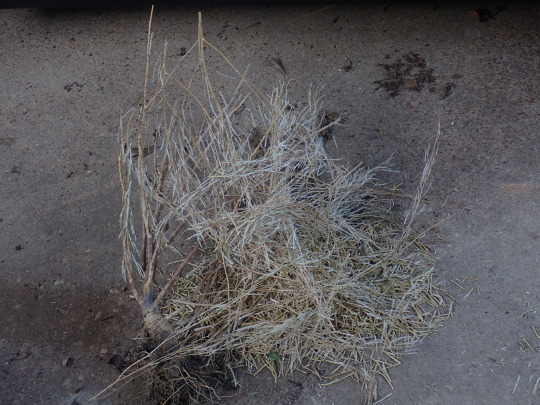
A future of food for us:

#garden#backyard garden#flowers#lilies#phlox#phlox david#seedlings#garden cart#honeysuckle#collard green#collard green seeds#seed collecting#composting#life in memphis#repurposing#fragrant cloud honeysuckle
1 note
·
View note
Text
Full Spectrum LED Grow Lights - Westland
1. Full-spectrum plant growth lamp, integrated design, working voltage AC85-265V, built-in constant current power supply. Low power consumption, high light absorption rate, 90% of light is absorbed by plants. Adopt high-quality imported LED light source, imported high-transmittance PC transparent cover + aviation aluminum material, with a lifespan of up to 50,000 hours. The full-spectrum light formula contains all the light bands needed by plants, and covers the wavelengths after 660. The wavelengths of 660+730nm far-red light are irradiated at the same time, which has a gain effect on the photosynthetic rate and achieves a double-light gain effect.
【Application range of LED plant lights】: It can be widely used in aqueous solution cultivation, group cultivation of seedlings, plant factories, greenhouse cultivation, indoor, balcony, basement cultivation, horticultural seedling cultivation and other fields. This product is suitable for tissue culture of Dendrobium, Clematis, Potato, Banana, Tobacco, Masson pine, Bletilla striata, Paper mulberry, Red Maple, Gerbera, Anthurium, strawberry, tomato, green pepper, pepper, eggplant, bitter gourd, loofah, Tomato, cherry, melon, cantaloupe, grape, succulent, cucumber and other plant tissue culture and planting.
Second, the advantages of full-spectrum LED plant lights:
1. Save 50% of energy and electricity, no air conditioning to cool down;
2. Shorten the plant growth cycle, 5 days in advance a month;
3. Improve the quality, 100 trees can reach 95%;
4. The tissue culture seedlings grow evenly, without unevenness and stable growth;
5. Promote robust growth of seedlings, improve root vigor and chlorophyll content;
6. The leaves are green, the leaves are stretched, and it is easy to export;
7. Reduce plant deformities;
8. The light decay is as small as three thousandths;
9, long life 3-5 years without replacement;
Three, T5 T8 LED tissue culture lamp advantages:
1. Adopt customized band spectrum, the wavelength is consistent with the photosynthesis spectrum of plant growth requirements, and promote the rapid growth of plants.
2. The mixed spectrum of red, blue, orange, white, green and yellow is used for light distribution according to the physiological characteristics of plants, so that the growth of plants can meet the needs of customers.
3. The company cooperates with Taiwan chip packaging manufacturers to customize the wavelength required by plants to ensure that the peak of the wavelength is beneficial to the growth of plants.
4. The company and agricultural experts jointly study the physiological characteristics of plants, and find out the light compensation point and saturation point of each plant. Maximize plant light.
5. The company has 0.2w\0.5w\1w different light sources, and recommends different power and light distribution growth lights according to different applications of customers.
T8 LED grow lights have greater advantages over fluorescent lights. Under the same illumination conditions, the LED can emit a larger photosynthetic effective photon flux density. The LED light source can adjust the illuminance and the light quality ratio of red, blue and white according to different plant species, so as to provide the most suitable light environment parameters for plants. At the same time, LED is a cold light source with very little heat radiation, which can irradiate plants at close range and effectively utilize the planting space, multiply the unit yield, greatly reduce the cost, and significantly save the power consumption per unit of space.
Fourth, the main technical parameters of LED plant growth lights:
【Product Name】LED Full Spectrum Plant Growth Light
[Brand name] RIYAO/Sunlight Lighting
【Product Model】Westland-T812
[Lamp material] aluminum profile + high light transmittance PC
【Input voltage】AC85-265v, 50-60HZ
【Power consumption】18w
【Luminous flux】1800lm
[Light source] Imported ultra-bright LED lamp beads for plant fill light
【Product size】L1200*W30*H35mm
【Power Efficiency】91%
【Power factor】PF>95%
【Lighting angle】120°
【Color rendering index】ra≥80
[Height from the plant] 20cm-40cm
【Warranty】2 years
[T5T8 plant light specifications] 0.6m 9W, 0.9m 14W, 01.2m 18W
0 notes
Text

I have once again planted an unreasonable amount of seedlings on my balcony. The tomatoes on the right picture are the ones sown in January, they're almost ready to get planted outside! I'm considering planting a few in March just to see if there's a chance they survive. If they did they would make huge tomato plants and produce earlier than any other plant, and if they don't make it, I have plenty more!
Even though there are so many plants I can hardly fit them on my balcony and it is overwhelming to keep up the watering, I deeply need all of these as my emotional support. Also there's plenty of stuff that didn't make it! Onions never grew even though I tried multiple times, and my sweet potato just rotted instead of growing new seedlings. The flowers are not really coming up either, I only have a few unknown little flower plants.
I'm still planning to start another wave of tomatoes and also to start cucumbers, squash and cantaloupes so this is not over. I wish I had a greenhouse or a conservatory for this!
#seedlings#gardening#plants#transplants#tomatoes#peppers#eggplants#ground cherries#i have one rosemary cutting somewhere in there#heaven knows if she will make it
12 notes
·
View notes
Photo


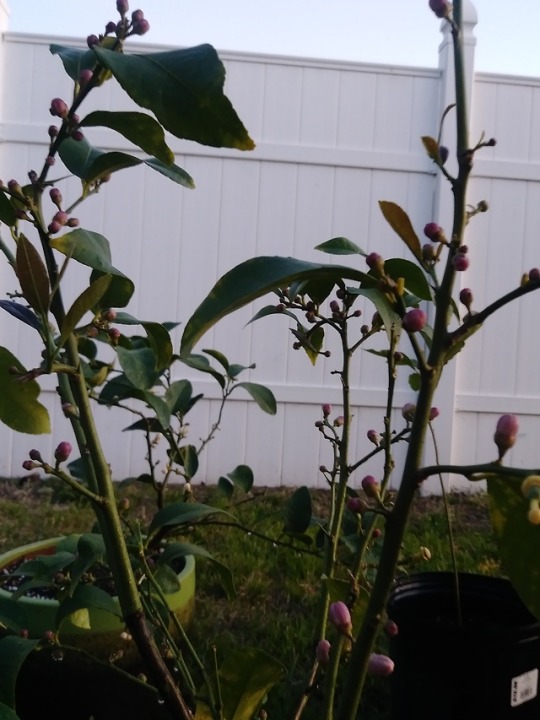
Meyer lemon blossoms and cantaloupe seedlings April 1st 2018
1 note
·
View note
Text
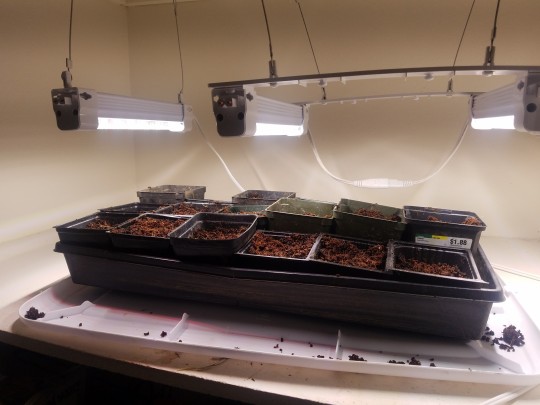


Well the first seedlings are in. Ive already half forgotten what i planted but i think it's mostly a ton of peas and beans, plus some cantaloups, basil, parsley, and sage. Had to move the grown basil outside though, cause theres not much room in the pantry. At this point it's mostly just the occasional overnight frost to kill things, so as long as i bring them in at night when its too cold they should survive a while longer
#they were starting to get burned by the lamps anyway#and i had it as high as i could#also of course another chuck feature#she sleeps like that sometimea but other times it means trouble#anyway despite how little I've done i'm pretty sure i overextended myself bc i already feel like death#i was sitting the whole time 😖#i think imight just walk to the dispensary#bc im out again and i can feel another migraine coming bc it was Somewhat Bright Outside#and also. how to put it delicately. i feel as though i have been hit by a truck#id have to walk tho. was gonna pick them up after work when id have the car#i got my cane out of the car at least tho#but i dont wanna move :(#chronic illness#gardening
36 notes
·
View notes
Photo

Mixed Heirloom organic Melon and Watermelon Seeds - Non-GMO, Fruit Seeds, Melon Seeds Bin#25 SURPRISE PACK Get your hands on melons and find out what other varieties you can grow in the comfort of your garden or home! A list of some of them will be listed below and we are offering them in this incredible package deal! Open-pollinated mixed varieties of seeds. 100% NON-GMO Real Survival Seeds. Guaranteed Fresh, Vegetable Gardening Seeds Non Hybrid Seeds GROWN IN THE USA A diverse gene pool mix of ultra-early, cool weather tolerant melons. Small, single serving, baseball-to-softball-sized melons vary in color (lots of green-fleshed but also some orange) as well as texture and flavor. You might not know what you’re going to get, but even the ones you’re less excited about are rather tasty. # of Seeds per Packet: 25+ Pepper Seeds Planting Instructions: Thrives in hot weather. Melons are ready to harvest when they easily slip off the vine when lifted. Sow seeds indoors 8-10 weeks before the last expected frost date in your area. Soak seeds in water for 4 days prior to sowing. Cover flats with a humidity dome to retain moisture and set in an 80-85°F location. Harden seedlings off gradually and transplant to a sunny garden location after all danger of frost is past and the weather is settled. For best results when starting seeds indoors use Seed Starting Mix and Trays. 10-12 Days for seeds to germinate from the date of sowing. 60-80 Days to maturity from the date of sowing your seeds. Germination rate 95% Sprouts In: 7-14 days Ideal Temp: 75 - 90 F Seed Depth: 1/2 inch Plant Spacing: 4' apart Light: Full Sun Days to Harvest: 60+ Days Species: Variety of Melons (incl watermelons). We do NOT make any claims that you will receive all 250+ seed varieties since we have no way of knowing which are which. Allsweet, Amish, Amarillo de Oro (Spain), Arancino, Ashkabad (Turkmenistan), Banana, Batekh Samara, Crane, Cavaillon Espagnol (Spain), Crenshaw, Casaba, Crenshaw, Cantaloupe Golden Summer, Charentais (France), Dune, Delice de la table, D'Alger (Algeria), De Almeria (Spain), Ethiopian, Golden Jenny, Galia, Golden Midget, Hara Madhu (India), Ha'Ogen, Healy's Pride, Honeydew Green Melon, Honey Rock Cantaloupe, Iridescent, Kajari (India), Kazakh (Kazakhistan), Kiku Chrysanthemum (Japan), Lemon Drop, Leelanau Sweetglo, Mango, Mahdu Ras (India), Noir de carmes (France), Olivin (Poland), Oregon, Queen Anne's Pocket, Petit gris de rennes, Prescott fond blanc, Piel de Sapo, Snow Leopard, Sweet Passion, Savor, Sweet Freckles, Sugar Baby Watermelon, Turkish Leopard (Turkey), Tiger, Thai Golden Round (Thailand), Thai Muskmelon (Thailand), Watermelon Crimson Sweet, White Lanzhou (China) Watermelon varieties may include Sugar Baby, Calsweet, Charleston Gray, Black Diamond, Jubilee, Allsweet, Crimson Sweet, Black Diamond, Shiny Boy, AU Producer, Charleston Grey, Desert King, Tendergold, Yellow Baby, Yellow doll, Crimson Sweet, Georgia Rattlesnake, Klondike Blue Ribbon Striped, Sweet Princess, Blacktail Mountain, Bush Sugar Baby, Sweet Beauty, Golden Midget, Little Darling, Mini Love, Black Diamond Yellow Belly, Carolina Cross #183, Florida Giant, Big Tasty, Mini Piccolo, Triple Crown, Orange Crisp, Orangeglo, Orange Tendersweet, Gold in Gold, Mountain Sweet Yellow, Yellow Petite, Cream of Saskatchewan, Kleckleys Sweet, Sangria F1 Hybrid What is the best way to plant watermelon? Sow your watermelon seeds in pots in mid-to-late May. In order to do this, fill some pots with seed-starting formula and sow each seed at a depth of 1 inch. You should sow 2-3 seeds per pot. Keep the soil moist and warm, at a temperature of 21 – 22°C What month do you plant watermelon? Plant watermelon from late spring to early summer, once soil temperatures reach 70° F or above. Space watermelon 3 to 5 feet apart in nutrient-rich, well-drained soil with a pH of 6.0 to 6.8. Sweet, fragrant, and brimming with juice, melons are the original thirst quencher. Since they’ve been cultivated for thousands of years, they come in an amazing range of sizes, colors, and shapes. The most popular type sold in the US is the orange-fleshed cantaloupe, which is actually a type of muskmelon, or netted melon. (True cantaloupes are smaller and available mostly in Europe and the Middle East.) Other grocery-store standards include the honeydew, a reliably sweet green-fleshed melon, and of course, numerous varieties of watermelons. But increasingly, more unusual types are found in local farmer’s markets from August through early autumn. FREE GIFT when you order 5 items or more. Free gift is full of surprise seeds which may include single or mixed varieties. Some, such as the Charentais, with its dark orange flesh and musky aroma, don’t ship well and are best bought locally. Other exotically-named varieties you might find include the slightly spicy Crenshaw, the super-sweet white-fleshed Canary, or the aptly named Tangerine Dream watermelon. Note: No tracking # will be provided to make the shipping cost-effective for us and free for you. Returns & exchanges Not accepted. But please contact me if you have problems with your order http://springsofeden.myshopify.com/products/mixed-heirloom-organic-melon-and-watermelon-seeds-non-gmo-fruit-seeds-melon-seeds-bin-25-surprise-pack
#Vegetable seeds#Heirloom melons#Non-GMO Seeds#seeds#organic seeds#Cantalopue Seeds#Fruit Seeds#Melon Seeds#Canary Melon#watermelon#amish melon#honeydew#kajari melon
2 notes
·
View notes
Photo
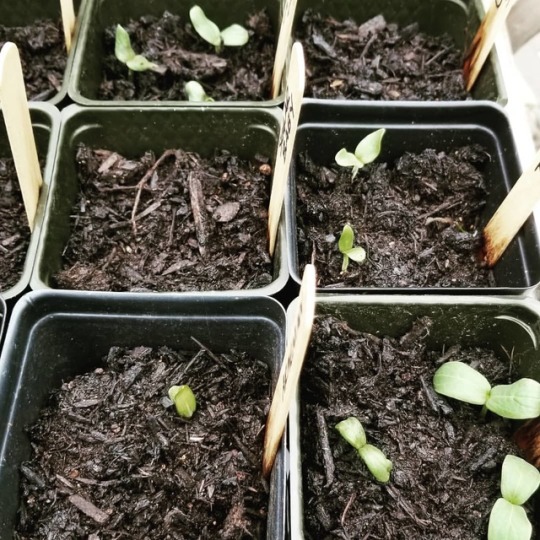
Happy birthday, little #cucurbits !! I so look forward to eating you! What's popping up in your garden that's got you excited?? #notquiteahomestead #homesteadlife #huerta #urbanhomestead #urbangarden #cantaloupe #honeydew #cucumber #melon #futurepickles #growyourfood #permaculture #raisedbedgarden #organic #organicgarden #gardenlove #gardenher #horticulture #seedlings #growsomethinglovely #aasgardenwinners @bakercreekseeds @seeds_now @ferrymorseseed @highmowingorganicseeds (at Harpers Ferry, West Virginia) https://www.instagram.com/p/ByXuWRSAqtC/?igshid=1xc4p9urt0wkz
#cucurbits#notquiteahomestead#homesteadlife#huerta#urbanhomestead#urbangarden#cantaloupe#honeydew#cucumber#melon#futurepickles#growyourfood#permaculture#raisedbedgarden#organic#organicgarden#gardenlove#gardenher#horticulture#seedlings#growsomethinglovely#aasgardenwinners
0 notes
Text
Sunday August 2nd,
I've been long overdue for an update. My new job has kept me so tired I barely have time for things like this.
My girlfriend has been taking care of the garden in my absence, she's been doing a great job.



I harvested my radish seeds so I can sow again next year. I tried to use a jar and shake it but ultimately I just ended up doing it by hand.
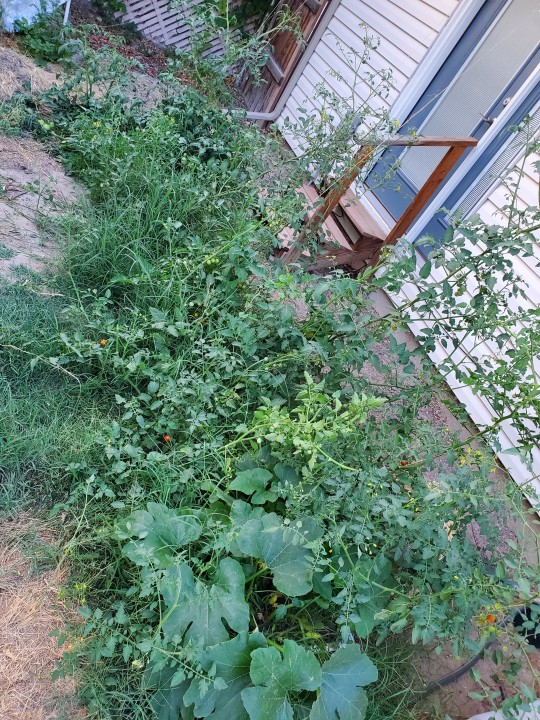

Before and after pics from cleaning up the tomatoes. The difference might not be that noticeable, but I did quite a bit of pruning and cleaning up around the bases of the plants.
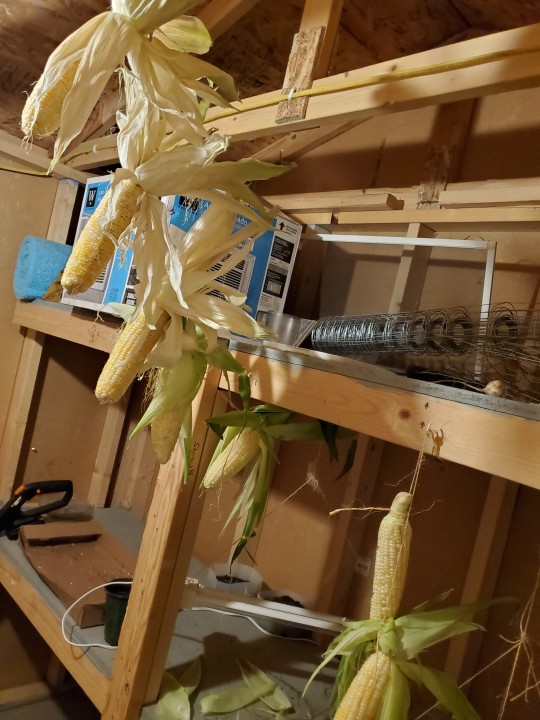
Another project I took on with all the sweet corn I take from my job. Hanging it to dry to make cornmeal. I don't have any kind of mill or sheller but that's a problem for future me.

The mystery gourd on the trellis is a butternut squash 😳. Hopefully it is strong enough!

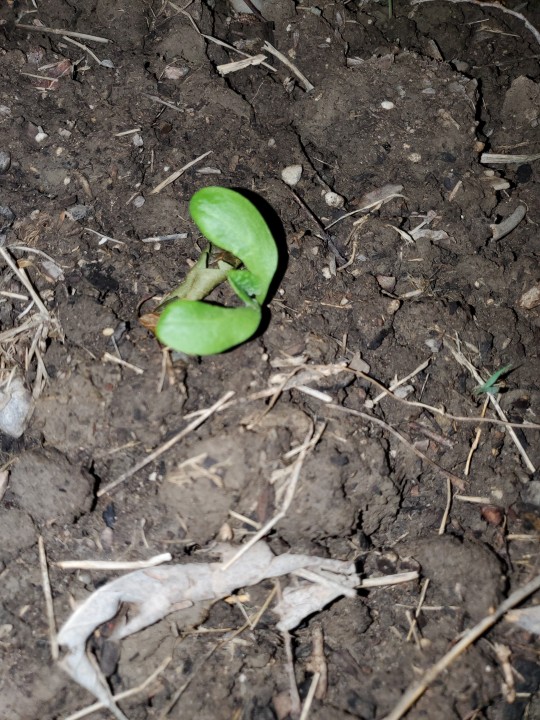
Our first little tomatillo, which is turning out to be one of our primary crops. And a tiny little burdock seedling. I'm burdock both to mine nutrients from the deep soil, to break up the soil deeper than my shovel can reach, and to eat.
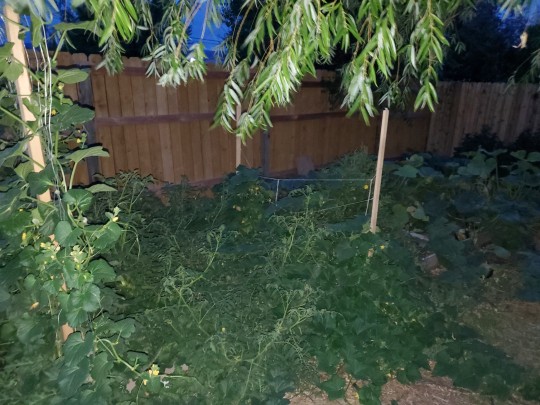
Our beds are very lush. Several watermelons, cantaloupes, tomatoes, and a small army of cucumbers.
We've been giving a lot to our neighbor, she's a nice old lady who, by some miracle, isn't a trump supporter. I have good luck finding liberals in my area, my new bosses also hate trump. At the end of the day I know they are really pretty centrist given their age, but it beats the alternative.
That's for now. We'll see if I can find time to update as the summer winds down.
Keep growing
67 notes
·
View notes
Text
Solarpunk Action Week
I’m a bit late in making this post, but I guess this just means I can summarize everything I did!
Sunday March 8th - I learned how to sew! It was with a sewing machine, just a few straight seams, and for a cosplay (I ultimately didn’t get the chance to wear due to Events) but it was my first time trying to sew anything in a really long time, so I’m pretty thrilled about it!
Tuesday March 10th - I planted A Lot of seeds! Sage, Dill, Chives, Thyme, Peas, Cantaloupe, and red kidney beans! This was the main Thing I had planned for SPAW, and I’m glad I managed to get it done!

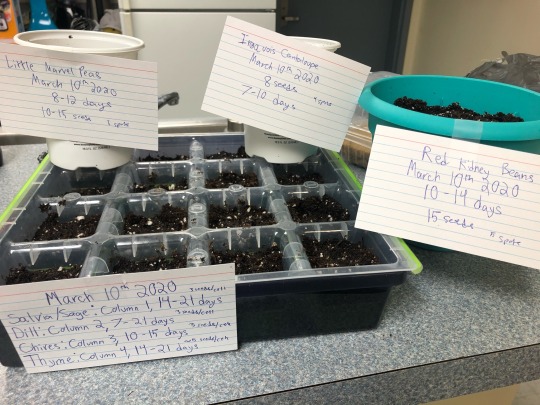
Wednesday March 11th - I early voted on my college campus! And there were people outside giving away pots and seeds for people who early voted, so I got more plants to care for! I tried to encourage my friends to (early) vote too, with undetermined success.


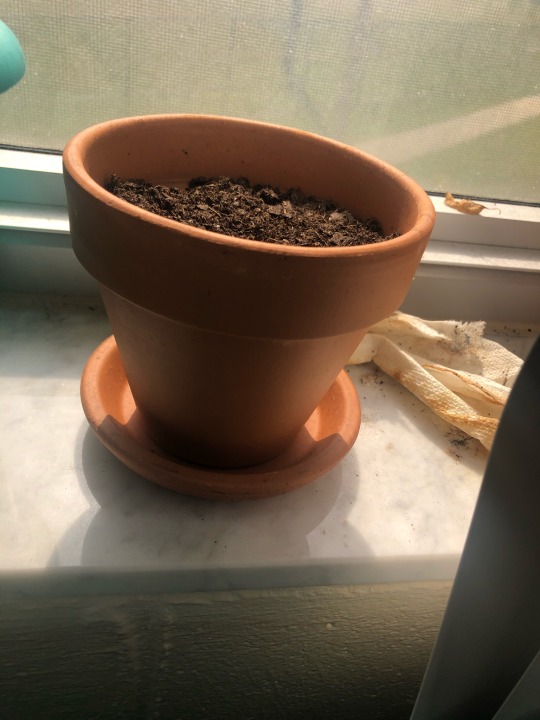
Sunday March 15th - watered my plants this morning! The peas are already sprouting, as well as something in the wildflower mix! I propped up my seed starter a bit, because it still was damp from when I watered it on Tuesday, so we’ll see how that develops!


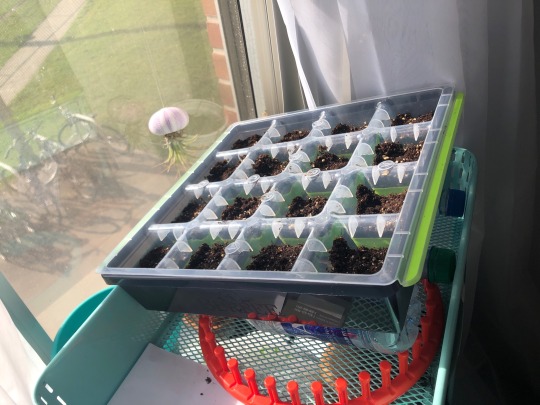
Ultimately, this was really fun, and I’ll definitely be excited to watch these seedlings grow (while I’m self isolated).
#solarpunk action week#gardening#indoor gardening#seedlings#growing from seeds#my garden#out of queue#aniporiginals
68 notes
·
View notes
Text
13 Weeks In: Moving Meditation
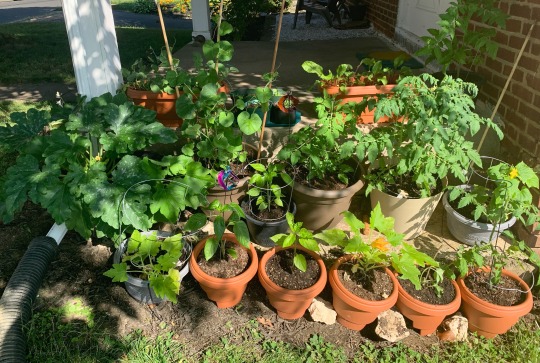
It has been 16 weeks since we began self isolating due to COVID-19. And 13 weeks since I put potting soil and seeds into cardboard egg cartons to start my first garden. This garden has brought me so much peace and calm during such an uncertain time. When I’m tending the plants I’m able to shut out the news and social media and my job. Its become a moving meditation, a way to reset when my anxiety is high or my mind needs help to quiet.
This week, one tiny zucchini started to form! Its about 5 inches long now and I’m amazed every time I lift the giant leaf it is hiding under to see how its doing. A group of tomatoes appeared Saturday morning that definitely wasn't there when I checked the garden on Friday. Our radishes grew a tall stalk with small light purple flowers at the top. And the cantaloupe has attached itself firmly to its bamboo stakes and is covered in flowers.


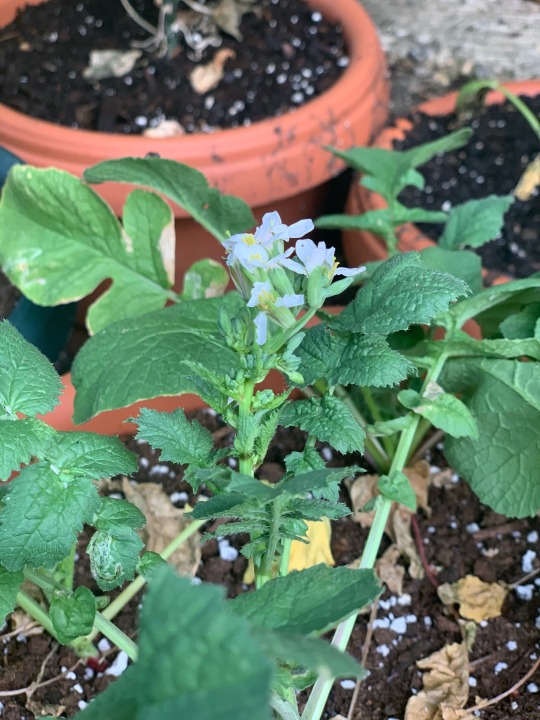
A few weeks ago, I started getting up early and going for a walk every day. Its so quiet in the morning and when I pass another person, which is rare, it’s easy to keep good distance. I smile passing rabbits eating clover in yards and admire the landscaping of the homes in our neighborhood. I listen to podcasts or music and establish a calm base for the morning.
When I get back from my walk I water the garden and check each plant, curious to see what new growth has happened over night. I noticed that the most well establish gardens get watered in the morning, which Google confirmed will prevent the plants in pots from getting moldy if they are too damp overnight. So I adjusted, but only after having lost all of my cucumber seedlings to mold.
I started new cucumber seeds today, directly in the pots outside in the garden. Perhaps it’s too late in the year, but I figured it was worth a try. Hopefully these will fare better, now that the weather is more stable and I’ve done more research.
I’m learning I have to work hard toward each plant’s survival and have a backup plan, just in case they don't make it. Nature is fickle. And when it comes to gardening, the weather often does not feel like its on my side. But my plants are resilient beyond my wildest imagination and knowing I can always start over has empowered me to experiment and be creative.
This summer will look much different than most. Instead of planning a week away on vacation, or mourning the vacation lost, I’m determined to make home the oasis I need. We updated our patio with rocks beneath our feet and Adirondack chairs. In the evening I can sit and admire my garden, knowing each plant is there because I slowed down enough to help it into existence.
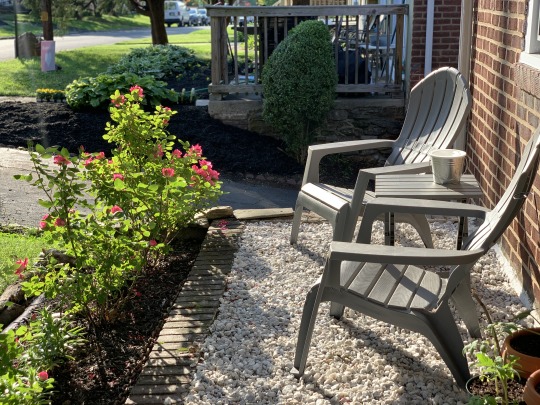
#gardening#victory garden#veggie garden#veggiegarden#grow your own#food not lawns#sustainable#green thumb#greenthumb#plantlove#Plant mom#covid garden#meditation#anxiety#mental health#nature#survival#zen#calm#self isolation#stayhome#staysafe
14 notes
·
View notes